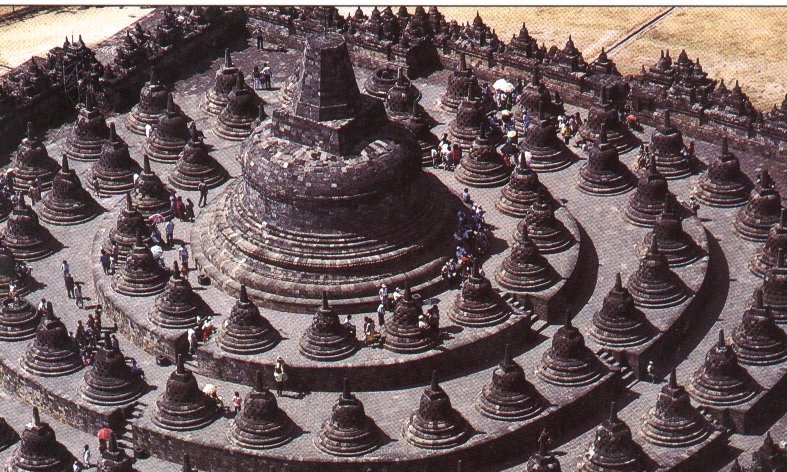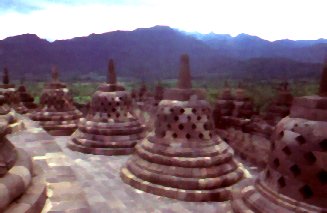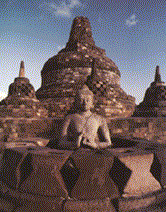
ARUPADHATU - Sphere of Formlessness
Before finally reaching the circular terraces, or the third and highest sphere - Arupadhatu -, the vistor enters a kind of plateau. The balustrade should hold 64 Dhyani Buddhas and still maintains the square shape of the lower galleries. The statues are symbols of the Buddha Wairocana, the ruler of Heaven and commander of the lower spheres. The inner wall of the gallery is now almost circular and carries no reliefs. This plateau represents the transitition from the sphere of Form into sphere of Formlessness, of the unimaginable and that which cannot be experienced.

The first terrace of the highest sphere accomodates 32 "stupas" or "dagobs", a repetition of the symbol of the Holy Mount Meru. Through the rhombic openings of each of trellised stupas, a Wajrasattva Buddha can be seen in a sitting posture, turning the dharma wheel (the wheel of life). The vast view from the temple - now undistracted by reliefs and balustrades - and the severe and concentrated architecture of the terrace and its stupas, must convey, even to the modern visitor, a sense of immense peace of mind. Contemplations on one's life usually end in touching one of the half hidden Buddhas, thereby taking away a promise of happiness and good fortune.

The simultaneousness of presence and non-presence depicted by the trellised stupas symbolized to the historic pilgrim or monk the highest stage of fulfilment. The fact that this stage again is devided into three terraces reveals the extreme subtlety of the monument's architects as well as of the religion itself.
The monks of the period after completion of the temple - at least during the fourteenth century - belonged to the "Vajradharas" sect. They are said to have had an unusually strong relation to magical practices and towards the female sex, which expressed itself in rituals of a slightly animistic character. The rare historic literature now and then indicates erotic excesses, which might correct the all too pure and idealistic picture of Buddhism of the modern visitor. According to some speculations, the fact that te reliefs are relatively free from eroticism - as compared to similar Indian reliefs - may have served as a kind of alibi for the actual events.
The second terrace has 24 Buddhas of identical posture and meaning. The visitors himself transferred into a world of abstraction, in which he feels himself the only tangible object. Across the vastness of the open space, coordinates are established to the surrounding lanscape, to the mountains and rivers, in whose shelter the temple was built. - The agonies mankind - who after all are responsible for the existence of this sanctuary - seem to disppear forever -. A last variation is seen on the third terrace, where 12 Buddhas are covered by trellised stupas of an even simpler design, with square instead of rhombic openings.
 The
highest and all overtowering main stupa in its plainness and abtraction symbolizes
the eternal peace after deliverance. This condition is no longer imaginable
to mankind; It is Nirvana, forever concealed and nevertheless emitting all power
and laws which govern the world and the mind.
The
highest and all overtowering main stupa in its plainness and abtraction symbolizes
the eternal peace after deliverance. This condition is no longer imaginable
to mankind; It is Nirvana, forever concealed and nevertheless emitting all power
and laws which govern the world and the mind.
As early as in 1814, an empty space was found inside the stupa, which gave rise to various speculations. There is the probability that this space had contained a large Buddha statue which was stolen at some time in the past. On the other hand, a statue of suitable dimensions was found in the vacinityof the monument, which from a scluptor's point of view had some flaws and perhaps for this reason was not used as planned but was buried instead.
Its also posible that the stupa had once contained a statue of the temple's founder and ruler of the Cailendra Dynasty, whose name is unknown but who may have been worshhiped as a Godking (devaraja). It may have been robbed or taken to secret hiding place by the last descendents of that dynasty at the time of its decline. Another theory and possibly a more logical one maintains that the builders left this space intentionally empty, in order not descrate the sphere of Nothingness through human attemps at symbolizing the indepictable.
Back to Map of Borobudur Library Contact us
© INSIST 2001